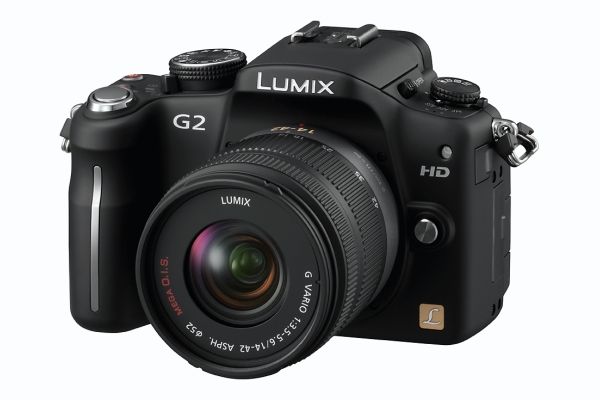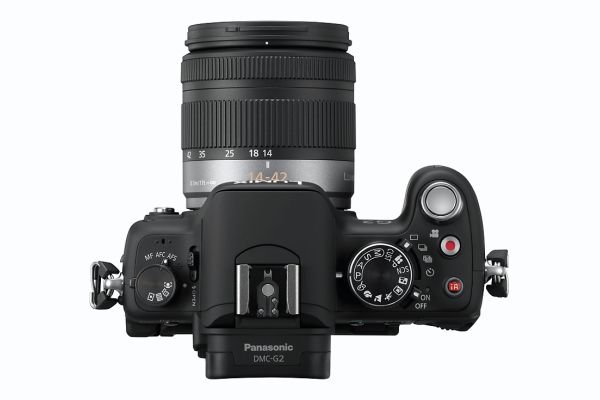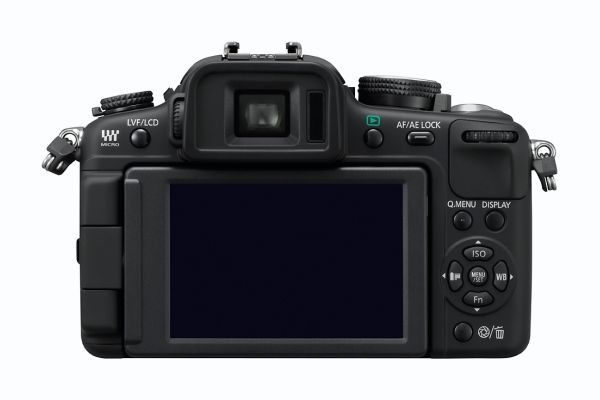Panasonic's latest Micro Four Thirds G-series camera, the Lumix G2, picks up the reigns where its G1 predecessor left off by adding two key new features - touchscreen functionality and an HD 720p movie mode.
Our quick take
The G2's touchscreen functionality aligns it where all current technology is headed - from the mobile phone in your pocket to the ticket machine you buy train tickets from. Far from being gimmicky, touch adds that extra dimension that makes perfect sense for quick-selecting AF points or utilising the camera's subject-tracking AF mode.
The G2's contrast-detect AF system is very snappy when compared to much of the competition out there and, while it's not going to see off a nippier DSLR system, it's certainly a class-leading, decent, usable alternative.
Sure the electronic viewfinder may not be to everyone's taste and high ISO image quality is a let down, but with a decent tilt-angle LCD screen, quality 720p HD movie, a whole bunch of customisable Scene and My Color modes to add to the creative fun and a batch of decent (albeit expensive) additional lenses available, the G2 shows the continued success of Micro Four Thirds. We like it a whole lot.

Panasonic Lumix DMC-G2 hybrid camera - 4.5 / 5
| FOR | AGAINST |
|---|---|
|
|
For those unfamiliar with the G-series, the Micro Four Thirds concept or indeed any of the other interchangeable lens compact systems (see the Samsung NX10 and forthcoming Sony NEX series) that have appeared recently, here's a quick overview. The cameras have a relatively large, DSLR-like sensor, but lack the mirror box that a DSLR has and thus cannot operate the same way. Instead constant live view to screen and, in some cases, electronic viewfinders (EVF) feature as an alternative and, on the upside in many people's views, you get a much smaller size and weight than a DSLR system.
The ability to change lenses as per a DSLR system and the small, more compact-like size is where the commonly used "hybrid" name comes from. Plus, with success comes competition - Samsung's NX and Sony's forthcoming NEX systems both offer interchangeable lenses but are not part of the Micro Four Thirds standard. Instead these solo-ventures have larger sensors and individual manufacturer lens fittings.
The Panasonic G2 has a 12.1-megapixel Micro Four Thirds sensor and the kit formation comes with a 14-42mm image stabilised lens for a shade under £600. This new lens differs slightly from the 14-45mm kit lens of old, with a marginally shorter focal length and, although image stabilisation (Mega OIS) does feature, there's no quick access stabilisation on/off switch on the lens barrel itself.
As per the Lumix G1 before it, the G2 has a free-angle 3-inch 460k-dot LCD screen that can tilt through 270 degrees vertically and 180 degrees horizontally. It's great for getting unusual views such as above crowds or when crouching down low and looking to get an unusual composition. The biggest advance the G2 brings into play here is the addition of touchscreen functionality that entirely changes the way the camera can be controlled.
Although not every area utilises touch - such as when in the main menu for example - there are certain features like subject-tracking AF that use it to full effect: touch a single finger to the desired subject on screen and the camera will follow said subject and automatically maintain focus. Similarly moving AF priority points around on screen becomes a breeze - certainly much faster than the menu digging and button pressing of old.
It may not be as silky smooth or fully immersive as controlling many of the current smartphones out there, yet then that's an entirely different comparison at this early stage. What does make the touch process all the more seamless is that all the usual array of buttons work just as expected in providing you with the choice of how to control the camera.
However, as much as we may like the LCD screen's new-fangled innovations, the G2's electronic viewfinder (EVF or Live Viewfinder (LVF) as Panasonic calls it) is a slightly different story. The high resolution (1040k-dot) and full angle of view are there, plus the EVF automatically activates when nearing the camera to your face without needing to press any buttons, sure, but those familiar with the large image provided by a DSLR's optical viewfinder may find the electronic version is of no comparison. Firstly there's slight image lag in dimmer lighting conditions and secondly the overall image is smaller and feels "further away" from the eye.
Saying that, pop the LCD display into "Live Viewfinder mode" and all the controls you could need when shooting become immediately available on the LCD screen itself for your nimble fingers to quickly access. Plus, should the sun's rays be particularly blinding one day, causing notable screen glare, then the EVF can become a mightily useful tool indeed to ensure accurate exposure and composition. It won't be everyone's cup of tea, but it does the job amply.
When shooting, the G2's autofocus is very swift for a contrast-detect AF system and, although not as speedy as most DSLR cameras will offer, is a decent compromise that outperforms most compact-like cameras. To the left of the camera is a mode dial for selecting AF-points (Multi, Spot, AF-tracking and Face Detection) and also the AF mode features on a rotational switch to the side - AF-S (single autofocus), AF-C (continuous autofocus) and Manual options are available.
The new 720p HD movie mode can capture 1280 x 720 at 50p (sensor outputs at 25fps for the UK release, or 60p at 30fps for the NTSC US release in accordance with PAL and NTSC respectively) using the highly regarded AVCHD Lite's H.264 codec or, should you choose, Motion JPEG format. When shooting in AVCHD Lite you can view images on the camera itself, but extracting movies for external use will require processing, whereas the slightly lower quality Motion JPEG format can be easily extracted as a .MOV file with no further processing.
There's a one-touch button to the top of the camera so it's possible to slip seamlessly into shooting a movie at any point. As the G2 isn't technically a camcorder its video clips are limited to 29 minutes and 59 seconds maximum per take, though this gives plenty of time to catch the majority of what you will need and outperforms some DSLR systems that only offer shorter recording times. During recording it's possible to use any of the AF-S, AF-C or manual focus options with any given lens attached.
Given the G2's contrast-detect AF system the continuous focus can glide past the point of focus before attaining final focus, which is a common but frustrating issue. Furthermore when hand-holding the G2 it's fairly tricky to manually focus lenses, though this is less a fault of the camera itself and more an overall observation of using such DSLR-like cameras - the pro videographers out there may wish to invest in a video tripod.
The G2 has droves of scene modes and even a My Color option on the top dial for creative colour adjustment - be that Expressive, Retro, Silhouette or a Custom setting. Peripheral Defocus is a particular favourite mode that allows a cursor on screen to obtain focus wherever it is dragged (be that physically with the touch of a finger or using the directional buttons).
Other shooting modes include full Manual control, as well as Aperture and Shutter Priority and Program Auto modes for fullest control as and when needed. This makes the G2 ideal for first timers as well as more experienced photographers looking for the same level of control that a DSLR would offer in a smaller package. There's also an intelligent Auto mode (iA) that auto-selects all the best settings for the scene at hand and can be easily activated using a one-touch button on top of the camera that lights up a fetching blue colour to indicate its use.
The Micro Four Thirds sensor provides a 2x crop, meaning it's half the size of a full frame 35mm DSLR. However this is far bigger than the sensors that can be found in most common compact cameras and as such final image clarity, detail and overall quality from the G2 is very good indeed. Sensitivity runs from ISO 100-6400, though the new heights of ISO 6400 prove to be a step too far, even with the new Venus HD Engine II's processing power - ISO 6400 has too much image noise that results in colours becoming dull, darkened and the whole image lacks any good definition.
However, stick to the ISO 100-1600 range and images are decent, with only a grain-like quality progressively creeping into images as the sensitivity increases. However, with the recent Samsung NX10 released to market (which has sensor almost some 50% bigger than the G2's offering) the G2 can't quite keep up in terms of clarity in the higher ISO settings, though when shooting in good light during the day this won't be an issue.
Sharpness-wise, the new 14-42mm Mega OIS lens is perfectly acceptable but isn't the best out there; its inclusion in the kit package keeps the overall cost down however. Look to buy a GH1, with its excellent 14-140mm optic and that kit option will set you back over the thousand pound mark. Pick up a G2 however and there are numerous other excellent Panasonic, Olympus and even Leica lenses available - from the 20mm F/1.7 to 14-140mm F/4-5.6 (and many others) - that offer considerable performance and sharpness. Unsurprisingly their purchase will require fairly deep pockets in most cases - but as the G2 is an expandable system it's well worth considering purchases at a later date for yet more creative control.
A new feature seen in a number of Panasonic cameras of late is the Intelligent Resolution technology that essentially analyses the image and smartly sharpens gradients, edges and textures to different degrees to provide a sharper overall final JPEG. For those looking to shoot RAW files, the G2 offers Panasonic's .SRW format that can be read and manipulated with the provided Silkypix 3.1 software (Adobe and Apple software updates will follow, though aren't available at the time of writing). RAW files are mightily similar to their JPEG counterparts, though maintain all the detail and are perfect for advanced snappers to archive or use when extensively processing images.
To recap
Far from novel the G2's new touchscreen capability extends its ease of use and is an ideal next step for the series to take. The 720p video mode is top quality, and although high ISO image quality is seen off by Samsung's NX10, the G2 holds its own on the performance front. A front-running Micro Four Thirds offering for sure



